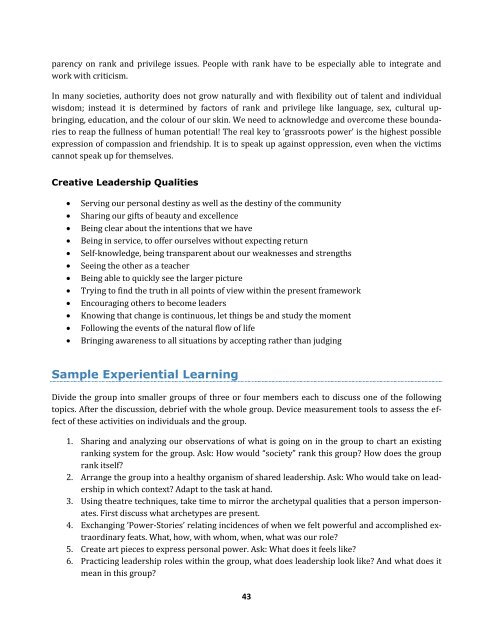EDE Curriculum 2012.pdf - Gaia Education
EDE Curriculum 2012.pdf - Gaia Education
EDE Curriculum 2012.pdf - Gaia Education
You also want an ePaper? Increase the reach of your titles
YUMPU automatically turns print PDFs into web optimized ePapers that Google loves.
parency on rank and privilege issues. People with rank have to be especially able to integrate and<br />
work with criticism.<br />
In many societies, authority does not grow naturally and with flexibility out of talent and individual<br />
wisdom; instead it is determined by factors of rank and privilege like language, sex, cultural upbringing,<br />
education, and the colour of our skin. We need to acknowledge and overcome these boundaries<br />
to reap the fullness of human potential! The real key to ‘grassroots power’ is the highest possible<br />
expression of compassion and friendship. It is to speak up against oppression, even when the victims<br />
cannot speak up for themselves.<br />
Creative Leadership Qualities<br />
� Serving our personal destiny as well as the destiny of the community<br />
� Sharing our gifts of beauty and excellence<br />
� Being clear about the intentions that we have<br />
� Being in service, to offer ourselves without expecting return<br />
� Self-knowledge, being transparent about our weaknesses and strengths<br />
� Seeing the other as a teacher<br />
� Being able to quickly see the larger picture<br />
� Trying to find the truth in all points of view within the present framework<br />
� Encouraging others to become leaders<br />
� Knowing that change is continuous, let things be and study the moment<br />
� Following the events of the natural flow of life<br />
� Bringing awareness to all situations by accepting rather than judging<br />
Sample Experiential Learning<br />
Divide the group into smaller groups of three or four members each to discuss one of the following<br />
topics. After the discussion, debrief with the whole group. Device measurement tools to assess the effect<br />
of these activities on individuals and the group.<br />
1. Sharing and analyzing our observations of what is going on in the group to chart an existing<br />
ranking system for the group. Ask: How would “society” rank this group? How does the group<br />
rank itself?<br />
2. Arrange the group into a healthy organism of shared leadership. Ask: Who would take on leadership<br />
in which context? Adapt to the task at hand.<br />
3. Using theatre techniques, take time to mirror the archetypal qualities that a person impersonates.<br />
First discuss what archetypes are present.<br />
4. Exchanging ’Power-Stories’ relating incidences of when we felt powerful and accomplished extraordinary<br />
feats. What, how, with whom, when, what was our role?<br />
5. Create art pieces to express personal power. Ask: What does it feels like?<br />
6. Practicing leadership roles within the group, what does leadership look like? And what does it<br />
mean in this group?<br />
43







